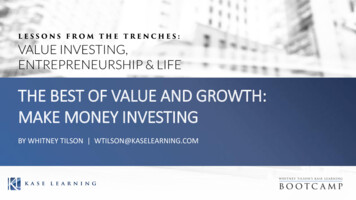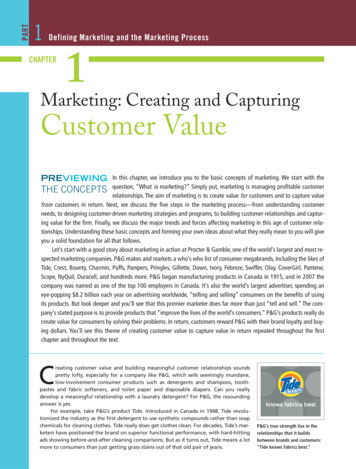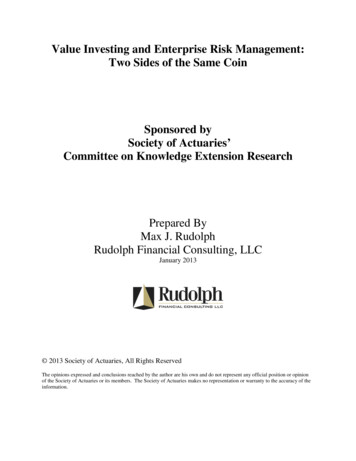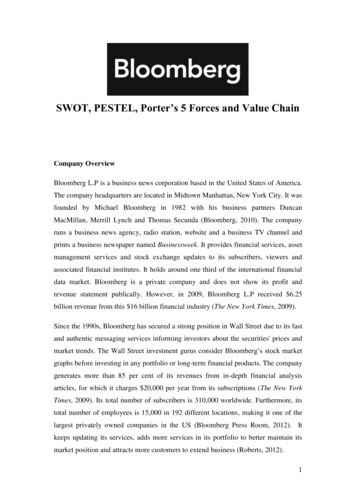
Transcription
THE BEST OF VALUE AND GROWTH:MAKE MONEY INVESTINGBY WHITNEY TILSON WTILSON@KASELEARNING.COM
I WAS AN OLD-SCHOOL VALUE INVESTOR I pray in the church of Graham, Dodd, Buffett and Munger I’ve been to the last 21 Berkshire Hathaway annual meetings I’ve co-authored three books on value investing:2
I BOUGHT CHEAP STOCKS As a value investor, I mostly owned stocks that were trading at lowmultiples of sales, earnings and/or book value In most cases, the stocks were cheap because the companies wereperforming poorly I cared about businesses’ quality and future growth prospects, but thiswas secondary to whether their stocks were cheap3
THE FOUR MISTAKES OF VALUE INVESTORSMy focus on cheap stocks led me to frequently make four mistakes thatare common among value investors:1.2.3.4.4Investing in low-quality businesses whose stocks were value trapsbecause the businesses’ fundamentals continued to declineFailing to buy high-quality businesses whose stocks were fabulouslong-term compoundersSelling the stocks of great companies way too soon because they’drisen and didn’t appear as cheapFailing to understand/appreciate powerful new technologies/trends
HOW A COMPANY PERFORMS OVER TIME ISMORE IMPORTANT THAN CURRENT VALUATION I estimate that 75% of what matters in terms of a stock’s performanceover time is how the company performs vs. only 25% the valuation atthe time of purchase For my entire career, I had this backwardsThis was a terrible mistake that costme and my investors dearly!5
THE FOUR MISTAKES OF GROWTH INVESTORSSo the message is: “Just buy the stocks of great growth companiesirrespective of valuation”? Not so fast Growth investors frequently make four mistakes:1.2.3.4.6They overestimate future growth, forgetting the powerful force ofreversion to the mean, driven by technology changes, newcompetitors, size acting as an anchor to growth, etc. Trees don’t growto the skyThey pay too high a price for a stock, such that even if the businessperforms well, the stock doesn’tThey fall in love with great companies and fail to sell when they shouldThey get sucked into “story stocks”
I’M NOW A MAKE MONEY INVESTOR I now combine the best aspects of both value and growth investing tomaximize my returns as a make money investor I want to teach you how to become one as well7
LESSON #1: STOCKS TEND TO FOLLOW EARNINGSSO FOCUS PRIMARILY ON BUSINESS QUALITY ANDGROWTH, BUT BEWARE OF EXTREME VALUATIONS
HIGH VALUATIONS HAVEN’TMATTERED FOR CERTAIN STOCKS
CASE STUDY: COSTCOA 25-bagger since 1994, driven by extraordinary profit growthStock price (red line)10 Source for all charts in this presentation: CapitalIQOperating income(trailing 12-month,not quarterly)(blue bars)
HOWEVER, EXTREME VALUATIONSCAN OFFSET EVEN ROBUST GROWTH
CASE STUDY: CISCOAfter briefly becoming the most valuable company on the planet, the stock is still down nearly two decades laterOperating incomeThe peak of theinternet bubbleStock priceForward P/E multiple12
BE ESPECIALLY CAREFUL OF VALUE TRAPS:COMPANIES WHOSE EARNINGS DECLINE AND DECLINE These value traps suck in value investors because they appear cheap allthe way down Is it extremely difficult to make money on a stock, no matter howcheap it is, if the businesses’ fundamentals steadily decline13
CASE STUDY: BED BATH & BEYONDA round trip of both earnings and the stock over the past decadeOperating incomeStock price14
LESSON #2:TRY TO IDENTIFY INFLECTION POINTS
THE BEST OF BOTH WORLDS: COMBINEVALUE AND GROWTH APPROACHES 16If you correctly identify great companies that grow strongly and buy theirstocks at anything but the most extreme valuation, you’ll do wellBut if you really want to make a lot of money, buy the stocks of suchcompanies when they’re out of favor and the valuations are reasonable (if notdownright cheap)If you catch an inflection point, there’s a double tailwind for the stock: earningsgrow and the multiple on those earnings expands as wellI am not talking about waiting for a market correction – 90 % of the time, youshould ignore the marketI’m talking about individual stock corrections, which are typically driven bychanges in sentiment toward the company or sector, or the companyexperiencing a short-term hiccup
CASE STUDY: BERKSHIRE HATHAWAYA wonderful buying opportunity at the peak of the internet bubble in March 2000Key insights Buffett was a brilliant investor Berkshire was a great company The stock was trading at cash &investments, so you got all of theoperating businesses for freeThe stock was cut in half,despite steady fundamentalsStock priceI put 30% of my fund in thestock the day it bottomed17Equity
BERKSHIRE’S STOCK IS UP 8x SINCE THENStock priceEquity(more closely tracks intrinsicvalue than operating income)18
HOW TO IDENTIFY INFLECTION POINTS
INFLECTION POINT VARIANT PERCEPTION An inflection point in a stock occurs when the consensus view is thatthe company will continue to stagnate/decline, but instead it grows They are very difficult to identify – but you don’t have to be exactlyright– “It’s better to be roughly right than precisely wrong” If you believe a company/stock is at an inflection point, then you havea variant perception – a belief that a company will perform muchbetter (or worse, if you’re shorting) than most investors expect But having a variant perception is easy – you must also be right!20
WHAT TO DO WHEN A POSITIONIS RUNNING AGAINST YOU? This is so hard! No wonder mismanaging this has blown up some of the world’s smartestinvestors It’s especially hard for value investors, for whom it is ingrained that alower price means “buy more!” (or a higher price means “short more!”) Classic value investors are going to screen a lot of value traps asattractive– We will probably buy some of them– Performance will be enhanced by recognizing mistakes on value traps andgetting out quickly instead of digging in stubbornly21
LESSON #3: LET YOUR WINNERS RUNONCE YOU BUY A GREAT STOCK, HOLD ONAS LONG AS THE STORY REMAINS INTACT(IT’S OK TO TRIM TO MANAGE RISK/POSITION SIZE)
CASE STUDY: BROWN-FORMANMaker of Jack Daniels and other spiritsOperating incomeMy friend Tom Russo bought the stock under 1 and hasnever sold a share, 35 years – and a 70-bagger– later!Stock price23
I SOLD FOUR OF THE GREATESTGROWTH STOCKS OF ALL TIME I not only owned but publicly pitched four of the greatest growthstocks of all time – Apple, Ross Stores, Home Depot and Netflix – andthen sold them far too early24
THE THREE MOST DANGEROUS WORDSIN INVESTING: I MISSED IT 25The four most dangerous words in investing are: “This time is different”The three most dangerous words are: “I missed it”The many case studies in this presentation highlight a critically importantpoint: just because a stock has moved up – even doubled or more – doesn’tmean it’s expensive and shouldn’t be boughtValue investors like to buy stocks trading at or near 52-week (if not multi-year)lows – it makes us feel like we’re getting a bargainI’ve lost count of how many times I’ve looked at the stock of a great companyand failed to buy it because it’s moved higher and I said to yourself, “I missedit. Maybe I’ll buy it if it pulls back” – but it rarely doesLesson: ignore where a stock has been and focus exclusively on where it’s likelyto go
YOU MUST SELL IF THEGROWTH STORY FALLS APART
CASE STUDY: VALEANTEarnings rose 11x, driving the stock up 20x – before it fell by 97%Summary Earnings growth was dependent on two drivers:acquisitions and price increases The former disappeared once the Allerganacquisition failed The latter disappeared thanks to Martin Shkreli There was plenty of time to get out, but someof the world’s smartest investors failed to seethat the growth story was gone and rode it allthe way downStock price27 (Valeant has been renamed Bausch Health Companies – BHC)Operating income
STOCK IDEA #1: ALPHABET (GOOGLE)
STOCK IDEA #2: FACEBOOK
STOCK IDEA #3: HOWARD HUGHES
PS: A FEW THOUGHTS ON BITCOIN
BLOCKCHAIN IS REAL, BUTCRYPTOCURRENCIES ARE A SCAM Like all great bubbles, the cryptocurrency one is rooted in somethinglegitimate, blockchain, which is real and important technology But cryptocurrencies will never gain widespread acceptance becausethere is nothing backing them and they are instruments of speculation,so their values swing widely– Think about it: would you ever accept payment in bitcoin (or any othercryptocurrency) if you had to hold it for more than a day?– The U.S. dollar, while not backed by gold, is backed by a 19 trillioneconomy and the government’s power to tax it The sector, not surprisingly, has attracted every form of promoter andfraudster32
I CALLED THE TOP OF THE BITCOINBUBBLE TO THE DAYIn my investing email to 6,000 subscribers on Dec. 16, 2017, when bitcoin peaked at 20,000, I wrote:Subject line: I'm calling the top of the bitcoin/cryptocurrency madnessIn the past week, I’ve been asked about bitcoin by a parade of the least-knowledgeableinvestors imaginable – and the only times such foolishness has happened before in my 18-yearcareer were at the peak of the internet and housing bubbles, so I’m calling a top right now.Blockchain technology is real in the same way that the internet was real back in 1999 andhousing prices tend to go up in the mid-2000s – in other words, a good idea taken to absurdextremes is NOT a good idea!That said, the greed and speculative nature of humans is inherently unpredictable, so for allI know bitcoin could go to 1 million.But I do know the ultimate outcome: smoldering rubble, a lot of finger-pointing (wherewere the regulators?!), and a lot of tears and empty bank accounts, especially among thosewho can least afford it.33
SINCE THEN, BITCOIN IS DOWN 67%Other cryptocurrencies are down far more34
PPS: THE CANNABIS STOCKS ARE IN ANEXTREME BUBBLE AS WELL
stocks at anything but the most extreme valuation, you’ll do well But if you really want to make a lot of money, buy the stocks of such companies when they’re out of favor and the valuations are reasonable (if not downright cheap) If you catch an inflection











